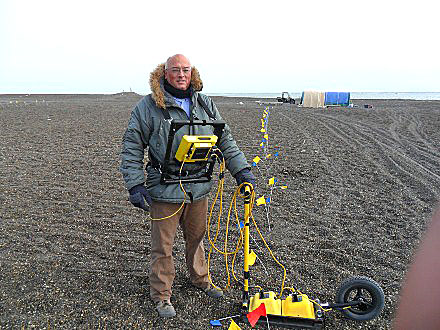
by Ann Brown
Radford University professor Rhett Herman and physics major Jared Palmer spent two weeks this summer on a remote beach searching for an ancient burial ground under meters of pea-size gravel. One might picture the pair taking a dip in the ocean or enjoying a frozen treat while wearing their flowered shirts and flip flops. Well . . . Not exactly.
“I’ll bet you all didn’t know what all the fashionable physicists are wearing these days,” Herman wrote in a descriptive email to friends back in Virginia. “I’m wearing parka by Alpha Industries, ski gloves by Walmart, turtle neck by Brystie Inc., heavy-duty work pants by Carhartt, and of course no outfit is complete without the shoes. These are by Brahma, and I can walk in them all day!”
Rather than the tropics, Palmer and Herman were in Barrow, Alaska, where they searched for lost burials of the Inupiat, the native people of the north slope of Alaska who once lived on Point Barrow, a barrier island. The ground of Point Barrow is eroding, and a team of scientists is searching for the burials before they are lost at sea.
Herman went on to describe 40 degree conditions with a 20 mph wind – “soul crushingly cold,” he wrote home. “Our faces are seriously wind burned.” The pain was worth it, however. Data the researchers collected led to discovery of a human so well preserved that details of the burial clothing could be studied.
In partnership with the Nuvuk Archaeology Project and its top scientist, Anne Jensen, Palmer and Herman used two ground-penetrating radar (GPR) units to survey the area the team believed to be the site of a cemetery from a lost settlement, hoping to find human remains or other pertinent artifacts. “It turned out that we were at the purported southern extent of this burial area,” Herman said. “They expected to find nothing, but we had to be sure.”
Using their geophysical technology, the Radford team found an ancient beach line on which ancient people had built structures. “Now we are hoping to get the National Science Foundation to get the project additional funds to hire a backhoe to dig down to the level where the beach line is so that they can do the recoveries quickly,” Herman said.
Large excavation equipment is essential because the beach’s pea-size gravel fills any hole more than about 20 inches deep. “Digging down even 1 meter requires a crater of nearly 5 meters across. Digging down 2 meters requires heavy machinery,” Herman said. “The project team thinks our GPR data will tip the scales at the National Science Foundation in their favor in their race against the rising sea levels.”
On Palmer and Herman’s last day of data collecting, they found a large anomaly at an unusual depth. In previously excavated burials, remains would be found at about 2 feet because of the frozen ground where the burials were made. “Jared and I told Dr. Jensen that these extraordinarily strong anomalies were down about 30 centimeters deeper,” Herman said. “It turns out that it’s the deepest burial she’s seen in her 15 years working on this dig.”
Jensen posted on her blog (http://networkedblogs.com/kA2Gk): “The very deep burial turned out to be a person wearing a fur parka and wrapped in hide! You can even see traces of the stitching. We aren’t sure how well preserved the person is (we found a few finger bones and a nail inside the cuff). We decided to take it out “en bloc” and take it back to the lab to excavate in controlled conditions so we can document the garment better, since it is very fragile. We had some plywood brought out and managed to slide it through the gravel under the entire burial and lift the whole thing. This required the digging of a very large hole, which we’ll now need to backfill.”
Before 1997, when the first human remains were found at Nuvuk, most anthropologists thought nothing of archaeological interest was left at Point Barrow. In the years since, it has become clear that the Nuvuk site was home to Thule people, ancestors of today’s Inuits, since the 10th century and before that to the Ipiutak people in the fourth century, according to the Nuvuk Archaeology Project website.
Herman hopes the latest data will fuel further geophysical research in the area. The pair will submit an abstract based on their research for the fall meeting of the American Geophysical Union in San Francisco in December. Their research poster will include all data collected during their time on the barrier island.
